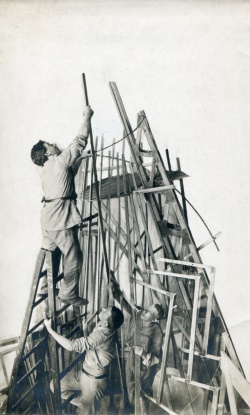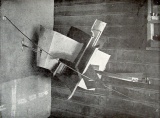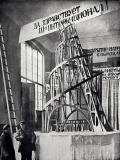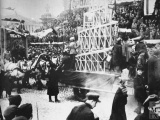Difference between revisions of "Vladimir Tatlin"
| Line 43: | Line 43: | ||
==External links== | ==External links== | ||
| + | * [http://oxfordindex.oup.com/view/10.1093/oi/authority.20110803102214200 Tatlin at Oxford Index] | ||
* http://www.artexpertswebsite.com/pages/artists/tatlin.php | * http://www.artexpertswebsite.com/pages/artists/tatlin.php | ||
Revision as of 15:44, 29 December 2013
 Vladimir Tatlin photographed building Monument to the Third International | |
| Born |
December 28, 1885 Moscow, Russian Empire |
|---|---|
| Died |
May 31, 1953 (aged 67) Moscow, Soviet Union |
A painter and architect.
Life and work
Born 1885 in Kharkiv, Ukraine, Russian Empire, to a railway engineer and a poet. Runs away from home and joins the Merchant Marine, works as a merchant sea cadet; continues to go to sea intermittently until 1914-15. Spends some time abroad.
Begins his art career as an icon painter in Moscow, and ultimately enters the Moscow School of Painting, Sculpture and Architecture; studies under the academic painters K. A. Korovin and V. A. Serov. Also a professional musician-bandurist, and 1906 performs at the Paris World Fair. By 1908 he is a friend of Larionov, the Burliuk brothers, the Vesnin brothers, as well as with the painter Lebedev and the sculptor Lebedeva, who would remain lifelong friends. 1909-10 he begins exhibiting fairly regularly in the principal avant-garde exhibitions in Odessa, Moscow, and Petrograd; with the League of Youth in 1911, 'The Donkey's Tail' in 1912, joins the Jack of Diamonds in 1912, shows at the League of Youth and World of Art exhibitions in 1913, the 'Tramway V' and 0.10 in 1915, solo exhibition 'The Shop' in 1916; knows most of the significant artists of the period. 1911 his first stage designs, for 'Czar Maximillian and His Unruly Son Adolf' in Moscow. 1915 public conflict with Malevich over his 'suprematist' works shown at the time of the 0.10 (Zero-Ten) exhibition, also called "the last futurist exhibition", what leads Malevich to develop his ideas further in the city of Vitebsk. Spring-Summer 1913 travels briefly to Berlin as a bandore player, and subsequently to Paris, where he visits Picasso in his studio, returns to Russia and begins producing Relief Constructions (1913-17), a series of sculptures made from wood, iron and an assortment of junk and other "found" materials for hanging in wall corners, in an imitation of similar works by his Spanish host. 1917, together with Rodchenko, he works under George Yakulov on the interior decoration of Moscow's Cafe Pittoresque.
Constructions culminate in a commissioned extraordinary model for Monument to the Third International (an unfinished wooden prototype), exhibited in Petrograd (now St Petersburg) in November 1920 and in Moscow in December 1920, and which quickly became a symbol of the Constructivists. The monument was conceived as a working building, an enormous skeletal apparatus a third higher than the Eiffel Tower at 1,300 feet high. Inside the iron-and-steel structure of twin spirals, the design envisaged three building blocks intended to house the executive, administrative and propaganda offices of the Comintern, covered with glass windows, which would rotate at different speeds (the first one, a cube, once a year; the second one, a pyramid, once a month; the third one, a cylinder, once a day). Resembling a huge functioning machine made of iron beams and glass, the tower demonstrated the power of the machine aesthetic as a symbol of revolutionary objectives. Tatlin declared that he was restoring the essential unity of painting, sculpture and architecture, "combining purely artistic forms with utilitarian intentions.. The fruits of this are models which give rise to discoveries serving the creation of a new world and which call upon producers to control the forms of the new everyday life" (Bann, p 14). High prices prevent execution of the plan.
Since 1918 involved with pedagogy, reorganizing the curriculum of the State Free Art Studios, and teaching 'Volume, Material, and Construction' (1919-24), 'Culture of Materials' (1921-25), and wood- and metalworking and ceramics (1927-30). 1922 appointed the head of the woodworking studio. Continues to work on stage decors until his death.
His glider Letatlin is assembled in 1930-32 in the tower of the Novodevichy Monastery in Moscow with students from the Vkhutein.
He made stringed musical instruments throughout his lifetime. At the end of his life he starts to research bird flight, in order to pursue one of the great dreams of humanity: to fly. Died 1953.
Works
Literature
- Jürgen Harten (ed.), Vladimir Tatlin: Leben, Werk, Wirkung: Eine internationales Symposium, Cologne: DuMont Buchverlag, 1993. (in German)
- Lutz Becker (ed.), Construction: Tatlin and After, Thessaloniki: State Museum of Contemporary Art, Costakis Collection, 2001.
- Von Kandinsky bis Tatlin: Konstruktivismus in Europa/From Kandinsky to Tatlin: Constructivism in Europe, Schwerin: Staatliches Museum; and Bonn: Kunstmuseum, 2006. (in German/English)
- Tatlin: neue Kunst fur eine neue Welt: Internationales Sympoisum / Tatlin novoe iskusstvo dlya noogo mira. Mezhdunarodnyi simpozium / Tatlin: new art for a new world: Intenational Symposium, Basel: The Museum Tinguely, 2013. (in German/Russian/English)





